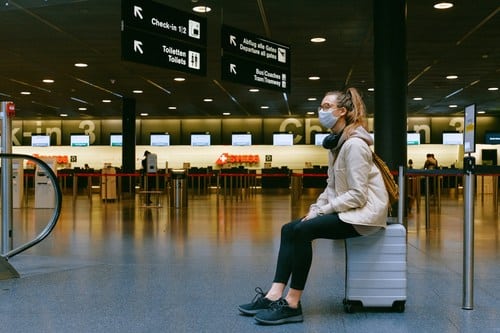Airlines
Airlines are getting tough on ‘personal items,’ and it could cost you

Airlines are becoming increasingly strict with regard to the dimensions of passengers’ personal belongings, and it may end up costing you much more than you had planned.
The definition of a personal item is typically stated clearly by airlines. A purse or small handbag that must fit under the seat in front of you, for instance, is how Americans interpret it. No more than 18 by 14 by 8 inches should be the bag’s measurements.
According to a recent analysis by IdeaWorks and CarTrawler, American Airlines, for example, made a record $7.42 per passenger in baggage revenue in 2021, bringing in $1.22 billion systemwide. Many travelers have been informing me that the rules governing carry-on and checked baggage have been more strictly enforced, which would be consistent with the increased income.
A la carte pricing for things like carry-on luggage have helped other airlines, particularly the ultra-low-cost carriers, build their businesses. According to travelers, they are particularly interested in the personal item category of luggage.
How are ‘personal items’ defined by airlines?
It is described as a purse or little handbag that fits beneath the seat in front of you by American Airlines. The bag’s dimensions shouldn’t be larger than 18x14x8 inches.
It can be a briefcase, a small backpack, a camera bag, or a diaper bag, according to Delta Air Lines. Personal items are not charged costs because they are not considered carry-on luggage.
Purses, backpacks, and laptop bags are considered personal items by United Airlines and must fit under the seat in front of you. Maximum dimensions are 17x10x9 inches.
As long as they fit inside the 16.25 by 13.5 by 8-inch space under the seat, Southwest Airlines does not impose size restrictions on passengers’ carry-on luggage. Bags, briefcases, cameras, food containers, and laptop computers in cases are examples of personal things.
The size of personal objects, including handles, wheels, and straps, which measure 14x18x8 inches, is strictly regulated by Frontier Airlines.

Airlines
Air India Rolls Out A350s for Delhi-New York JFK and Newark Routes

In a major development for North American travelers, Air India has announced the deployment of its state-of-the-art Airbus A350-900 aircraft on two key routes: Delhi to New York and Delhi to Newark.
The service on the Delhi-New York route will commence on November 1, 2024, while the Delhi-Newark route will see its inaugural flight on January 2, 2025.
The introduction of the air india a350 will bring significant enhancements to Air India’s offerings, particularly with the launch of its Premium Economy class. air india retrofit This new class will feature 24 wide seats arranged in a 2-4-2 configuration, providing passengers with extra legroom and a more comfortable flying experience.
Soon, Air India aircraft will feature onboard WiFi & all-new cabins: Click here
“We are encouraged by the positive guest feedback we have received from the domestic deployment of our air india a350 interior to offer our hero product on the Delhi-New York JFK and Delhi-Newark routes. This is a significant leap forward for our U.S. operations that also underscores our commitment to continuous improvement,” said Campbell Wilson, Chief Executive Officer & Managing Director of Air India.
The A350’s Business class will set new standards with 28 private suites, each equipped with full-flat beds, direct aisle access, and personal wardrobes. Economy class will be configured to accommodate 264 passengers in a 3-4-3 layout. Across all cabins, passengers will enjoy the latest Panasonic eX3 in-flight entertainment system, offering over 2,200 hours of content.
Air India’s First A350-900: Interior, Routes, &Inflight Features: Click here
This strategic deployment marks a notable enhancement in Air India’s U.S. operations, with 60% of its flights to the U.S. now featuring new or upgraded cabin interiors. The air india new international routes currently operates 51 weekly flights to five U.S. destinations: New York JFK, Newark, Washington DC, Chicago, and San Francisco.
The revamped cabins, advanced in-flight entertainment systems, and improved service standards represent air india wifi commitment to providing a superior travel experience. “We believe this enhanced offering will solidify Air India’s position as a leading carrier and attract travellers seeking a world-class flying experience between India and the United States,” the airline stated.
Seats on these flights are now available for booking on Air India’s website, mobile app, and through travel agents, ensuring that passengers can easily plan their journeys on these newly upgraded routes.
Air India Economy vs Qatar airways economy: which is best?:Click here
-

 Travel1 week ago
Travel1 week agoAir India to Expand US Operations with Three New Routes After a Decade
-

 Travel2 weeks ago
Travel2 weeks agoWhy We Should Avoid These Stamps in a Passport
-

 Airlines1 month ago
Airlines1 month agoInvestigations Reveal Fake Chinese Titanium in Boeing and Airbus Jets
-

 Tech4 weeks ago
Tech4 weeks agoChina’s CATL Plans 1,800-Mile Electric Plane Launch by 2027
-

 Airport3 days ago
Airport3 days agoTop 10 Largest Airports in the World by Size
-

 Aerospace4 weeks ago
Aerospace4 weeks agoChina’s Fighter Jets Turn Wings into Autonomous Drones
-

 Airlines4 days ago
Airlines4 days agoAir India Rolls Out A350s for Delhi-New York JFK and Newark Routes
-

 Defence3 weeks ago
Defence3 weeks agoBoeing Enhances Chinook with New Engines and Block II Upgrades at $96 Million







